Minnesota got dumped on this weekend with nearly fifteen inches of snow in some areas. With hardly any snow last winter, we almost forgot what a real snow storm looked like. I haven’t heard about any concerns over ice dams yet, but I suspect they’ll be coming very soon. The perfect conditions for ice dams are large amounts of snow and temperatures in the teens and twenties, which is what we’re expected to have this week.
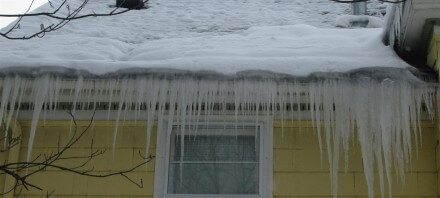
Two years ago, many Minnesota homeowners experienced ice dams like never before. The two things that everyone wanted to know was how to get rid of ice dams and how to prevent ice dams. Today, the focus is going to be on prevention.
How Ice Dams Form
Because it’s been a couple of years since I’ve blogged on the topic of ice dams, here’s a quick refresher: ice dams are literally dams of ice that form on roofs and cause water to back up. The dams form when the snow that touches the roof melts, and then that water freezes again before running off the roof. This usually happens at the edges of roofs, but not always. Here’s a great diagram showing how this works, courtesy of Steve Kuhl.
The best way to prevent ice dams from forming is to address the three factors in your attic that contribute to ice dams; insulation, ventilation, and attic air leaks.
Attic Air Leaks (aka – attic bypasses)
This is the largest contributor to ice dams. In almost every house with ice dams, there will be attic air leaks directly below the beginnings of the ice dam. Attic bypasses are passageways for warmed air to enter in to the attic space, and traditional insulation won’t fix this. The photos below show some common attic bypasses that can be found in just about any older house. The image series below shows how an infrared camera can be used by a home inspector or energy auditor to locate these bypasses.
The photo below shows one of the largest and most common bypasses – the space around the furnace and / or water heater vent. Sometimes these are huge. The one shown below is relatively small, but allows a lot of air to leak up in to the attic.
In the photo below, you can see several holes in the top plate of a wall that were drilled for wires to pass through. These holes could all be easily filled with spray foam, but finding these holes all over the attic would be a challenge without first removing the insulation, or performing an infrared inspection with a thermal imaging camera. The insulation had to be pushed aside to find these and take this photo.
With additions, the transitions between the ‘new’ and ‘old’ construction seem to always be sources of attic bypasses. The gap below was easily identified with the use of an infrared camera, but a lot of insulation had to be moved to get to the bottom of it.
When plumbing vents enter in to the attic, the space around the vents needs to be sealed. This one obviously wasn’t.
Some older houses have whole-house fans that are designed to run on hot summer nights; these fans are gigantic sources of heat loss, because they’re usually not insulated or sealed up. The photo below was taken from inside the attic without a flash. There’s some crazy heat loss occurring there, and as you might imagine, there was a huge ice dam nearby. No infrared camera needed to find this.
Old ramblers often have stairwells with nothing covering the top – you could fit an entire family in this dead space. It looked fine in the attic until the insulation was pulled away to show that this area was completely open.
The space around masonry chimneys is also a notorious location for attic air leakage.
What makes many of these attic bypasses so difficult to locate is that they’re almost always buried in insulation. Finding these buried air leaks can turn in to a guessing game for someone without a lot of experience in digging through attics.
If you have these types of bypasses in your attic, my recommendation is to have an insulation contractor seal the air leaks. They’ll know where to look and how to seal them properly. If you want to do the work yourself, download this guide from the Minnesota Department of Commerce – Attic Bypasses, and this guide from Building Science.com – Attic Air Sealing Guide and Details. These guides both give some excellent information on how to properly seal all of these air leaks yourself, and they discuss other concerns that need to be considered when performing attic air sealing, such as combustion appliance safety, knob & tube wiring, and vermiculite insulation.
If you plan to have more insulation added to your attic, have the air leaks sealed first. This can’t be stressed enough. This is the driving force behind ice dams, and is even more important than having insulation added. If your home was built before about 1990, it’s almost a guarantee that you’ll have attic bypasses that need to be sealed all over the attic. Unfortunately, many insulation contractors just add insulation on top of what’s already there without sealing the air leaks.
Insulation
This is a basic concept that everyone understands; you need insulation in your attic. If there are voids in the insulation, they need to be fixed. If there isn’t enough insulation, add more. The current minimum requirement for new homes in Minnesota is insulation values between R-38 and R-44. This means about 10″ – 12″ of cellulose, or 12″ – 16″ of loose fill fiberglass, depending on the manufacturer.
I’ll follow up with another post on different attic insulation methods and challenges with insulating older attics in the near future.
Ventilation
Having adequate ventilation for the attic space will help to keep the roof surface cold, which will help to prevent snow from melting, which will help to prevent ice dams. Ventilation is required for attics, but it’s the last thing that should be considered when troubleshooting the causes of ice dams.
The traditional way to ventilate an attic was to have half of the ventilation provided by vents installed low, such as soffit vents, and the other half at the top, such as ridge vents. According to information shared at a recent seminar put on by Dr. Lstiburek here in Minnesota, a better way to ventilate the attic is to make the ratio about 1/3 high and 2/3 low. This means way more soffit venting than ridge venting.
If the soffit vents are dirty, clean them or replace the grills if they’re painted shut. Grills are cheap. If the soffit vents are blocked with insulation, install air chutes at the eaves inside to prevent the insulation from blocking the vents.
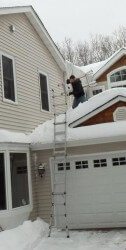 When all else fails…
When all else fails…
If you’ve already done everything you can think of to fix your ice dams but they keep coming back, or you hired a contractor to fix your ice dams two years ago but the ice dams have returned, call a home inspector or an energy auditor. We look at this stuff every day, and some of us even specialize in ice dam inspections.
Reuben Saltzman, Structure Tech Home Inspections

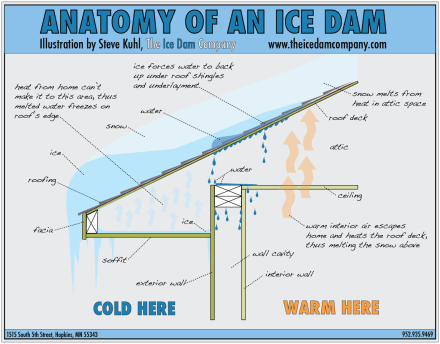


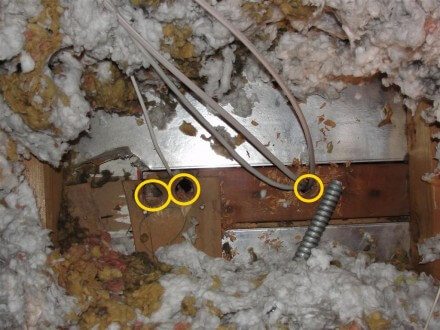

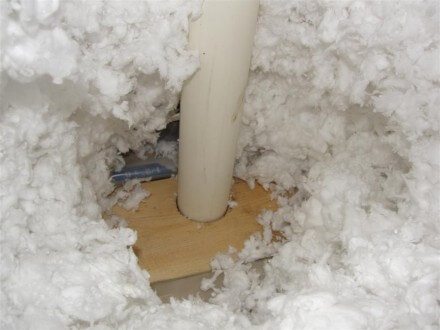
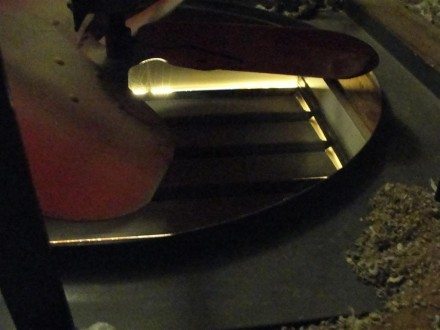
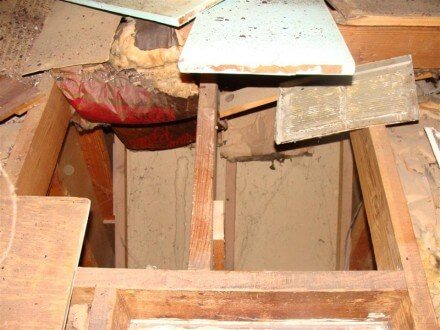





House Inspection
December 13, 2012, 10:43 am
Well, its really important to know that how ice dams are formed and then only possible to prevent it.
Mary
December 14, 2012, 2:41 pm
When you do your followup post on insulating older houses, please talk about removing vs. covering over vermiculite insulation.
Steve Kuhl
December 18, 2012, 10:08 pm
Hi Reuben. Here’s another item your followers might helpful. It’s a diagram noting the common signs of problematic ice dams.
http://www.kuhlscontracting.com/wp-content/uploads/case-12-Minneapolis-Ice-Dam-Warning-Signs.pdf
As always I enjoy reading what you have to say about home performance.
MCAS Roofing & Contracting
January 2, 2013, 6:43 pm
Homeowners often overlook the importance of insulation to prevent roofing damage. They think it only helps keep heating and cooling costs down. Good to see you bringing attention to this important roofing topic!
» How to Prevent Ice Dams
January 10, 2013, 3:42 pm
[…] Read the Full Post: How to Prevent Ice Dams […]
The Weekenders: Winter = Ice Dams « Upstater
January 16, 2013, 8:24 am
[…] Hopefully this will help us get through this winter, but over the long term, we need to do further insulation and ventilation work in the attic to hopefully keep it from happening again. […]
Poorly Insulated Eaves at Old Houses | Structure Tech Home Inspections
January 22, 2013, 5:21 am
[…] that this lack of insulation at the eaves starts to become a bigger concern is when the home has ice dams. Insufficient insulation at the eaves is a common contributor to ice dams, and there’s no […]
Unintended Consequences of Adding Insulation | Structure Tech Home Inspections
February 5, 2013, 5:01 am
[…] costs during the winter, and help to prevent snow from melting on the roof, in turn eliminating ice dams. That’s great, but what else changed that wasn’t supposed to? Here’s a list […]
How To Remove Ice Dams | Structure Tech Home Inspections
February 12, 2013, 5:29 am
[…] will be plenty of people dealing with leaking roofs from ice dams. I have already blogged about how to prevent ice dams from happening, but I get far more inquiries about how to remove ice dams. There are plenty of […]
How to prevent ice dams from the exterior | Structure Tech Home Inspections
March 4, 2013, 5:08 am
[…] written about how to prevent ice dams by fixing attic air leaks and insulation, as well as several hack methods showing how to remove ice […]
grace
March 21, 2013, 10:11 pm
New roof with 6ft of ice guard installed last spring and now very large ice dam by my north facing front door that never sees the sun. Never had this problem before. My gutter downspout and extentions are frozen solid with trailing ice traveling down the outside of the downspout despite having been cleared of snowcover. A few other changes, last spring changed whole house flooring from carpet to laminate and 2 yrs ago removed an evergreen that probably blocked some of the elements. Not sure that these things are even related. Lastly, last summer had an insulation contractor come by to look in the attic, unsolicited of course, hmmmmmm?? Would this be a case of newly sprung air leaks?
Reuben Saltzman
March 22, 2013, 3:41 am
Hi Grace, as you probably already know (but some readers may not), the ‘ice guard’ is there to help prevent leaks from happening, but won’t increase or reduce the formation of ice dams.
The change in flooring probably doesn’t have anything to do with it, and it’s unlikely that the removal of the tree had much effect as well. Newly sprung air leaks isn’t likely either. You would do well to hire someone in your area that offers infrared inspections to get to the bottom of it.
Ceiling Stains | Structure Tech Home Inspections
May 14, 2013, 3:57 am
[…] stains appear at the ceilings along outside walls at the corners, it’s typically the result of ice dam leakage. If the insulation in the attic is insufficient and there are attic air leaks, it’s very […]